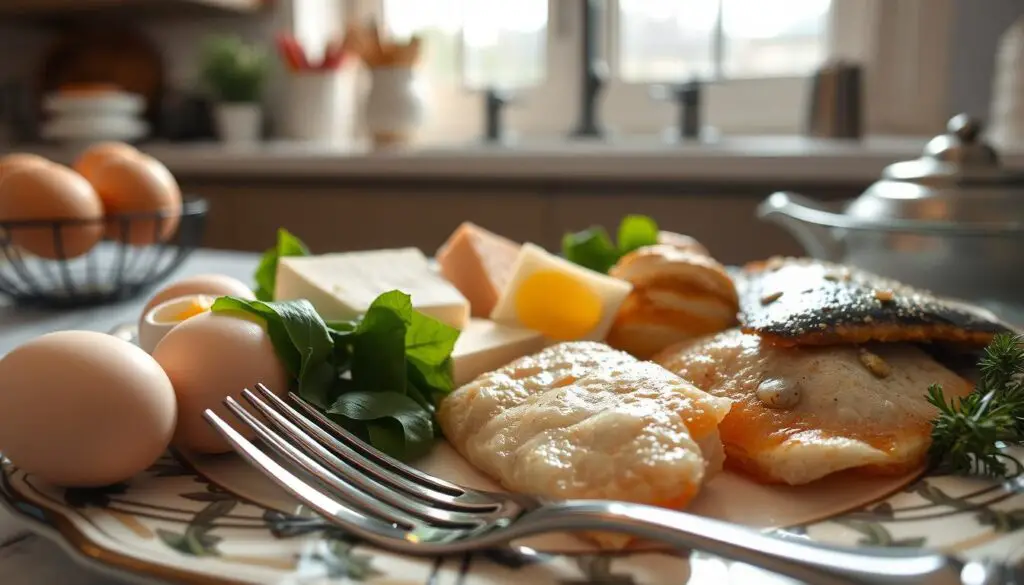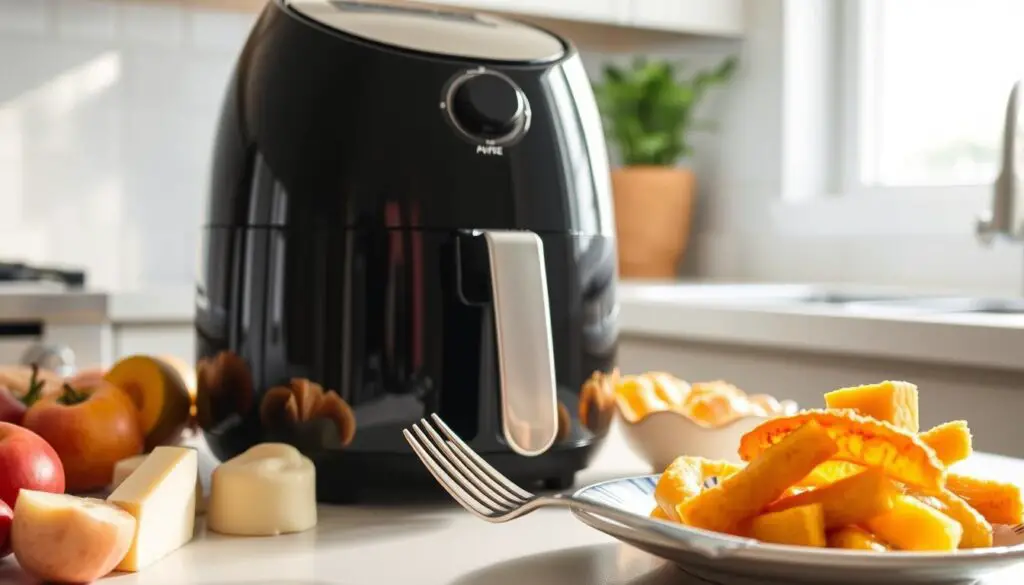Understanding which foods to avoid using in your air fryer is crucial for both cooking safety and achieving the best culinary results. While air fryers offer a fantastic alternative to traditional frying with healthier outcomes, there are common air fryer mistakes that could compromise the experience. Certain foods simply do not fare well in this versatile appliance, potentially affecting its efficiency and your meal’s quality. In this section, we will discuss the fundamental principles of air frying safety, offering essential cooking tips and air fryer guidelines to help you get the most out of your kitchen gadget. By being mindful of which foods not to air fry, you can ensure both delicious meals and safe cooking practices.
Key Takeaways
- Identifying five foods to keep out of your air fryer can enhance your cooking experience.
- Understanding how certain ingredients affect air fryer function is important for air frying safety.
- Being aware of common air fryer mistakes can prevent cooking disasters.
- Following air fryer guidelines will help you achieve delicious and safe meals.
- Careful preparation leads to better results when using your air fryer.
Understanding the Air Fryer
The air fryer has transformed the way home cooks approach meal preparation. This innovative appliance relies on the principle of circulating hot air around the food, allowing it to achieve a crispy texture similar to frying, but without the need for excessive oil. Understanding air fryer functionality is essential for maximizing the benefits of this kitchen device.
At the core of how air fryers work is a fan that distributes hot air uniformly. Brands like Philips and Ninja have advanced this technology further, making their models popular choices for enthusiasts. These appliances utilize various air fryer cooking methods, enabling users to bake, roast, and grill with reduced fat intake.
Common features found in air fryers include adjustable temperature settings, timers, and different cooking modes. Such features are designed to enhance user experience and ensure optimal cooking results. By mastering the air fryer cooking methods available, individuals can create healthier renditions of their favorite fried foods.
| Feature | Description |
|---|---|
| Circulation Technology | Utilizes a fan to circulate hot air, achieving a crispy finish. |
| Temperature Control | Allows precise cooking temperatures for various recipes. |
| Timer Function | Helps prevent overcooking by alerting when food is ready. |
| Multiple Cooking Options | Enables baking, roasting, grilling, and reheating foods. |
What 5 foods should you not put in an air fryer?
Understanding what foods to avoid in air fryer cooking is crucial for a successful culinary experience. Some ingredients do not fare well in this appliance, leading to air fryer cooking problems. It is essential to recognize why certain foods fail and to address the common misconceptions surrounding air fryer myths.
Why Certain Foods Don’t Work Well
Certain foods to avoid in air fryer include those that are overly wet or have a tendency to create a mess. For instance, wet batter-coated foods typically do not firm up correctly in an air fryer. Instead of achieving a crisp texture, the batter might drip and lead to a sticky interior. This can cause additional cleaning efforts after cooking. Other items may lack adequate structure or moisture content that disrupts an efficient cooking process, resulting in unevenly cooked dishes.
Common Misconceptions
Many home cooks believe all foods can be prepared in an air fryer without consequences. This air fryer myth can mislead users into attempting to cook items that fundamentally do not respond well to this method. Understanding the specific properties of various foods can prevent frustration and ensure a better cooking experience. By staying informed about the foods to avoid in air fryer, individuals can maximize their cooking success.

Foods That Should Never Go in an Air Fryer
When it comes to using an air fryer, adhering to certain air fryer food guidelines can greatly enhance your cooking experience. Some foods simply do not fare well in this innovative appliance. Understanding which items to avoid, such as wet batter-coated foods and leafy greens, can save you from frustrating kitchen mishaps.
Wet Batter-Coated Foods
Wet batter cooking issues arise when attempting to prepare items like onion rings or fish fillets that are coated in a wet batter. The moisture can drip during the cooking process, creating a soggy mess at the bottom of the air fryer. This prevents proper hot air circulation, which is crucial for achieving that crispy, golden-brown texture that air fryers are known for. Instead, consider using dry coatings or opting for fully fried methods for these foods to ensure the best results.
Leafy Greens
Leafy greens cooking, particularly with items like spinach or kale, often results in disappointing outcomes. When air frying these delicate vegetables, they tend to wilt quickly and lose their desired texture and nutritional value. Instead of air frying, it may be better to sauté or steam these greens to maintain their integrity and flavor.
Understanding these points aids in making informed decisions in the kitchen. For a further read about customization in breakfast options that may align with your cooking goals, you can check this resource.
The Risks of Cooking Certain Foods
Understanding the potential dangers of using an air fryer is crucial for maintaining health and safety in the kitchen. Certain foods can pose significant air fryer health risks due to the way they interact with the cooking environment. Choosing the right foods is not only about flavor but also about avoiding food preparation hazards that could lead to health complications.
Health Concerns
Improperly cooked foods can lead to harmful compounds entering your meal. When certain ingredients are heated at high temperatures in an air fryer, they may produce toxic byproducts. This poses various health risks and might result in foodborne illnesses, especially when moisture from foods responds unfavorably to the heating process. It’s essential to follow cooking safety tips to minimize these risks.
Potential Kitchen Hazards
In addition to health concerns, using inappropriate foods in an air fryer can lead to kitchen hazards. Grease splatters are common when cooking non-air fryer-friendly items, creating messy situations and potential burns. Furthermore, some foods may produce smoke, triggering smoke alarms and creating safety hazards. Implementing effective cooking safety tips can help mitigate these issues, ensuring a safer cooking environment.

Being mindful of the foods you choose can lead to a better and safer cooking experience. For delicious recipes that are air fryer-friendly, check out this guide on preparing corn on the.
| Food Item | Potential Risk | Recommended Action |
|---|---|---|
| Wet batter-coated foods | Sticky mess and improper cooking | Avoid using wet coatings |
| Leafy greens | Flammability | Use as a garnish instead |
| High-fat foods | Grease splatters | Consider lower-fat alternatives |
| Raw grains | Uneven cooking | Cook via boiling first |
Best Practices for Air Frying
To achieve the best results with your air fryer, it’s essential to follow air frying best practices. Proper food prep for air fryer plays a crucial role in the cooking process. By ensuring your ingredients are ready and suitable for air frying, you will enhance the flavor and texture of your meals.
How to Prepare Foods for Air Frying
Begin with cutting vegetables into uniform pieces for even cooking. A good size to aim for is about one inch. Remember to dry your ingredients thoroughly; moisture can lead to uneven cooking. When working with proteins, marinate them ahead of time to infuse flavors. Seasonings should be applied generously to maximize taste. Utilizing oil sprays can also help prevent sticking and create a crispier exterior.
Alternative Cooking Methods for Problematic Foods
Some foods do not fare well in an air fryer, prompting the use of alternative cooking methods. Steaming vegetables preserves their nutrients while ensuring even cooking. Baking offers a different texture and flavor profile, especially suitable for baked goods. Traditional frying allows for a rich taste but may come with higher fat content. Each method provides unique advantages, enabling diverse culinary experiences.
Safe Foods to Air Fry Instead
Exploring the world of air frying opens up numerous possibilities for creating delicious and healthy meals. Many safe foods for air frying can transform your kitchen experience while promoting inventive cooking methods. Proteins and vegetables shine in the air fryer, providing options that suit various tastes and dietary preferences.
Delicious Alternatives
When diversifying your air fryer repertoire, consider these safe foods:
- Chicken breasts or thighs seasoned with your favorite spices
- Fish fillets, such as salmon or tilapia, coated with herbs
- Root vegetables like potatoes, carrots, and sweet potatoes, cut into fries or wedges
- Brussels sprouts and broccoli tossed with olive oil and garlic
- Tofu, marinated and crisped for a delightful vegan option
These options embody ideal air fryer recipes that promise a satisfying crunch without the drawbacks of unsuitable foods. Experimenting with different marinades and seasonings can enhance flavors and elevate dishes, making cooking with an air fryer both fun and rewarding.
How to Experiment with Your Air Fryer
To maximize your air frying potential, embrace the spirit of experimentation. Try combining spices like smoked paprika or cumin with a drizzle of olive oil to create flavorful coatings for your meats and veggies. Mixing fresh herbs with citrus zest gives an exciting twist to your dishes.
Before diving into new recipes, ensure you preheat your air fryer for optimal results. It allows for even cooking and produces that coveted crispy texture. One suggestion is to cook in batches, avoiding overcrowding to maintain airflow. Leverage this technique to explore a broad range of air fryer recipes, each presenting unique flavors and textures.
With safe foods for air frying, your culinary adventures can flourish. Whether experimenting with traditional recipes or innovative combinations, the air fryer can transform your meal preparation approach, making it a valuable addition to any kitchen.
For more insights on foods unsuitable for air frying, check out this informative source.
Understanding Air Fryer Temperature Settings
Mastering air fryer temperature settings is crucial for achieving perfect results. Knowing the right cooking temperatures for various foods can significantly enhance your air frying experience. Whether you are preparing crispy vegetables or juicy meats, an effective air fryer temperature guide can make all the difference.
How Temperature Affects Cooking
The temperature at which you cook in an air fryer plays a vital role in determining food texture and flavor. Higher temperatures generally lead to crispier exteriors while ensuring that the insides remain tender. Proper preheating and the right warmth can drastically reduce cooking time, leading to better food quality.
Here’s a quick overview of recommended cooking temperatures for common foods:
| Food Item | Recommended Temperature (°F) | Cooking Time (minutes) |
|---|---|---|
| Chicken Wings | 400 | 25-30 |
| French Fries | 380 | 15-20 |
| Brussels Sprouts | 375 | 20-25 |
| Steak | 400 | 10-15 |
| Frozen Shrimp | 390 | 8-10 |
Employing these air frying tips will help you adjust the temperature settings based on the specific food you are preparing. Understanding how to manipulate these temperatures contributes greatly to enhancing your overall air frying skills.
Maintaining Your Air Fryer
Proper air fryer maintenance is essential for ensuring longevity and optimal performance. Regular cleaning and attention to common problems significantly improve the cooking quality. Here are some key points to consider regarding cleaning air fryer practices and troubleshooting air fryers effectively.
Cleaning Tips for Your Air Fryer
To maintain your air fryer, establish a routine cleaning schedule. Here are some helpful tips:
- Always wait for the unit to cool down before beginning the cleaning air fryer process.
- Use non-abrasive sponges or cloths to avoid scratching the non-stick surfaces.
- Remove and wash the basket and tray with warm soapy water. Most are also dishwasher-safe.
- Clean the heating element gently to prevent buildup of grease or food particles.
Common Problems and Solutions
Encountering issues during air frying is not uncommon. Here are some frequent problems and their solutions:
| Problem | Possible Cause | Solution |
|---|---|---|
| Smoke during cooking | Excess oil or food debris | Clean the basket and tray thoroughly; reduce oil usage. |
| Uneven cooking | Overcrowded basket or incorrect temperature | Do not overcrowd; adjust the temperature and shake the basket midway. |
| Strange smells | Accumulated grease | Conduct regular cleaning and check for buildup on the heating element. |

Expert Tips for Air Frying Success
Home cooks can elevate their air frying game by incorporating expert tips from professional chefs. Air frying tips focus on mastering timing, oil application, and enhancing flavors with seasonings. Following these cooking strategies can result in beautifully cooked meals that retain moisture while achieving the desired crispiness.
Learning from Professional Chefs
Many renowned chefs advocate for using minimal oil when air frying, stating that it enhances the natural flavors of ingredients without overwhelming them. Using high-smoke-point oils like avocado oil or grapeseed oil can provide tasteful results while minimizing health risks. Timing also plays a crucial role. Each ingredient may require specific cooking durations for optimal results.
“The beauty of an air fryer lies in its versatility. With practice and experience, you can unlock a new world of flavors.” – A Professional Chef
Seasoning is another critical aspect for achieving success. Chefs recommend applying spices and herbs not just before cooking but also during the cooking process. This layering of flavors enriches the dish and creates a multi-dimensional tasting experience. Experimenting with various seasonings can lead to unique flavor profiles, making each meal exciting.
| Tip | Description |
|---|---|
| Minimal Oil Use | Use small amounts of oil to enhance flavor without adding excess fat. |
| Proper Timing | Adjust cooking times based on the type and size of food for even results. |
| Layering Flavors | Add seasonings at different stages to maximize flavor depth. |
| Experimentation | Don’t hesitate to try new recipes and tastes to discover personal preferences. |
Conclusion
In summary, understanding the summary of air fryer guidelines is essential for maximizing the benefits of this versatile kitchen appliance. It’s clear that while air fryers offer a healthier alternative to traditional frying techniques, not all foods are suitable for this cooking method. Certain items, such as wet batter-coated foods and leafy greens, should be avoided to ensure safety and optimize results.
Furthermore, embracing safe cooking practices can help enhance your culinary experience. By following best practices for food preparation, you can enjoy crispier, more flavorful meals while minimizing potential hazards. Being mindful of what you choose to cook in your air fryer not only contributes to better health outcomes but also encourages creativity in the kitchen.
Ultimately, having reliable food preparation insights will empower you to make informed decisions that enhance your meals. By adhering to these guidelines, you can confidently explore the possibilities of your air fryer, ensuring a positive cooking experience each time you use it.

Thanks for sharing. I read many of your blog posts, cool, your blog is very good.